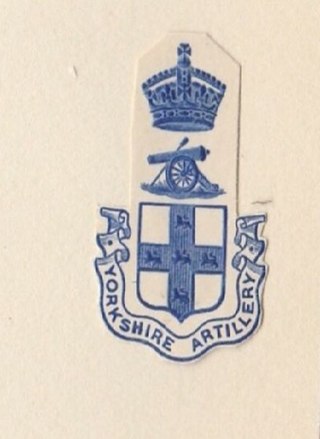The North Devon Militia, later the Devon Artillery Militia, was a part-time military unit in the maritime county of Devonshire in the West of England. The Militia had always been important in the county, which was vulnerable to invasion, and from its formal creation in 1758 the regiment served in home defence in all Britain's major wars until 1909. Having always been an infantry regiment, the North Devon Militia was converted into an artillery unit in 1853, with a role in manning the forts that protected the vital naval base at Plymouth.

The 1st East Yorkshire Artillery Volunteers was a part-time unit of Britain's Royal Artillery based in the East Riding of Yorkshire, which also contained sub-units from the North and West Ridings. Created during an invasion scare in 1859–1860, it survived to supply units to the later Territorial Force of the 20th century.
The Durham Artillery Militia was a part-time reserve unit of Britain's Royal Artillery based in County Durham from 1853 to 1909. Volunteers from the unit served in the Second Boer War where they distinguished themselves fighting as infantry in the defence of Fort Prospect.

The Yorkshire Artillery Militia was a part-time reserve unit of Britain's Royal Artillery based in the East and North Ridings of Yorkshire from 1860 to 1909.
The Duke of Edinburgh's Own Edinburgh Artillery was a part-time reserve unit of Britain's Royal Artillery based in Edinburgh from 1853 to 1909. Volunteers from the unit served in the Second Boer War.
The Royal Lancashire Militia Artillery was a part-time reserve unit of Britain's Royal Artillery based in Lancashire from 1853 to 1909.
The Antrim Artillery was a part-time reserve unit of Britain's Royal Artillery based in County Antrim, Northern Ireland, from 1853 to 1919. It numbered 1st on the order of precedence of the Militia Artillery. Volunteers from the unit served in the Second Boer War. During World War I it defended Belfast Lough and trained gunners for service overseas. Subsequent units continued the Antrim Artillery traditions.
The Mid-Ulster Artillery Militia was a part-time reserve unit of Britain's Royal Artillery based in Northern Ireland. Formed from three smaller units in 1875, it served until 1909.
The Dublin City Artillery Militia was a part-time reserve unit of Britain's Royal Artillery based in Dublin, Ireland, from 1854 to 1909.
The Kent Militia Artillery was a part-time reserve unit of Britain's Royal Artillery based at Dover in Kent, from 1853 to 1909.
The Galway Militia Artillery was a part-time reserve unit of Britain's Royal Artillery based in County Galway, Ireland, from 1854 to 1888.
The Royal Glamorgan Artillery Militia (RGAM) was a part-time reserve unit of Britain's Royal Artillery based at Swansea in Glamorgan, South Wales, from 1854 to 1909.
The Northumberland Militia Artillery was a part-time reserve unit of Britain's Royal Artillery based in the County of Northumberland, from 1854 to 1909.
The Argyll & Bute Militia was a part-time military unit in the west of Scotland from 1798 to 1909, serving in Home Defence during the French Revolutionary War, Napoleonic Wars and Second Boer War. Originally an infantry regiment, it was converted into artillery in 1861.
The Clare Militia was a British militia regiment from 1798 to 1909. It was based in County Clare. At first an infantry unit, it was converted to artillery in 1882, making it the last artillery militia unit raised in the British forces. It was disbanded in 1909.
The Sussex Militia was an auxiliary military force in Sussex on the South Coast of England. From their formal organisation as Trained Bands in 1572 they defended the coastline, watched the Spanish Armada and took an active part in the English Civil War. It was the Sussex Militia who captured the Duke of Monmouth after his unsuccessful Rebellion in 1685. After a long hiatus, the Sussex Militia was reformed in 1778 and provided internal security and home defence in all of Britain's major wars thereafter. It eventually became the Royal Sussex Light Infantry Militia (RSLIM) and also formed the Royal Sussex Militia Artillery. After the Cardwell Reforms the RSLIM became a battalion of the Royal Sussex Regiment and saw active service in the Second Boer War. It served as a Special Reserve training unit in World War I. After 1921 the militia had only a shadowy existence until its final abolition in 1953.
The 1st Inverness-shire Artillery Volunteers, later the Highland Artillery Volunteers, was a Scottish auxiliary unit of the British Army from 1860 to 1908. With its headquarters in Inverness, it was recruited for home defence from a number of shires in the northern Scottish Highlands. It later provided the basis for a number of Territorial Force units in the Highlands.

The Eastern Division, Royal Artillery, was an administrative grouping of garrison units of the Royal Artillery, Artillery Militia and Artillery Volunteers within the British Army's Eastern District from 1882 to 1902.
The Fifeshire Militia was an auxiliary regiment raised in Fifeshire, Scotland, in 1798. It served in home defence during the Napoleonic Wars and again during the Crimean War when it was converted into an artillery unit as the Fifeshire Artillery Militia. It served in home defence again during the Indian Mutiny and the Second Boer War. It was disbanded in 1909.



